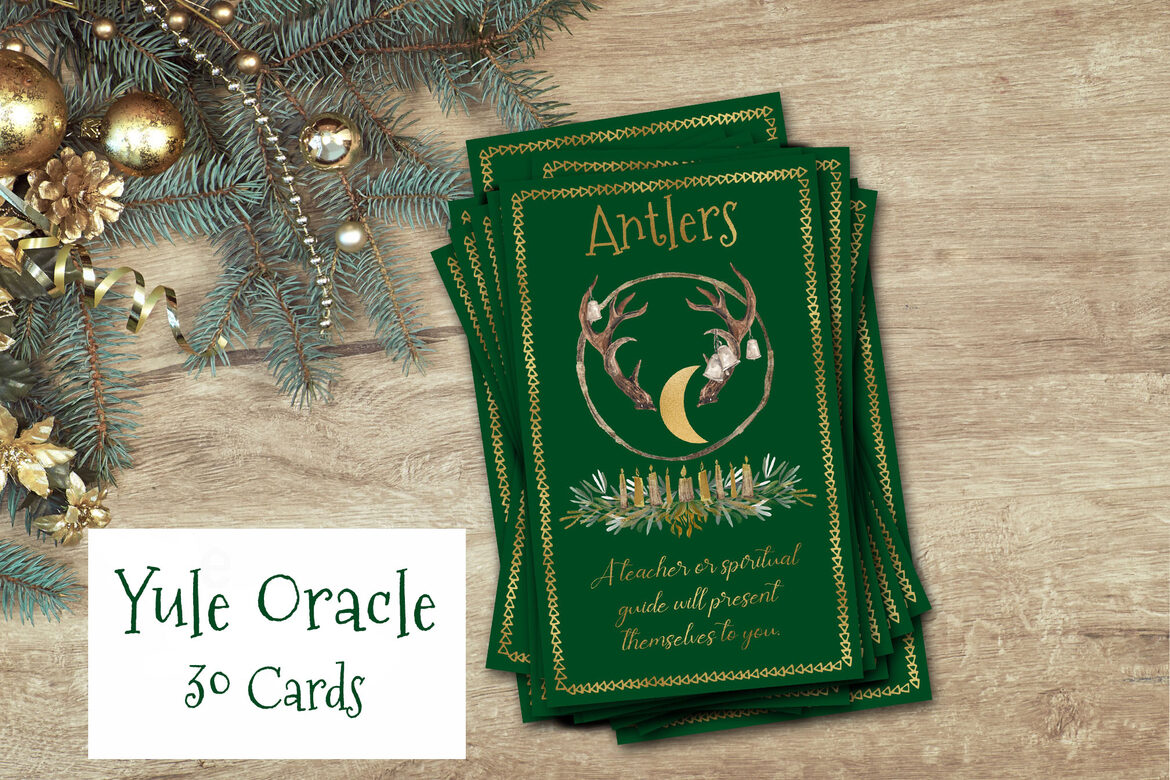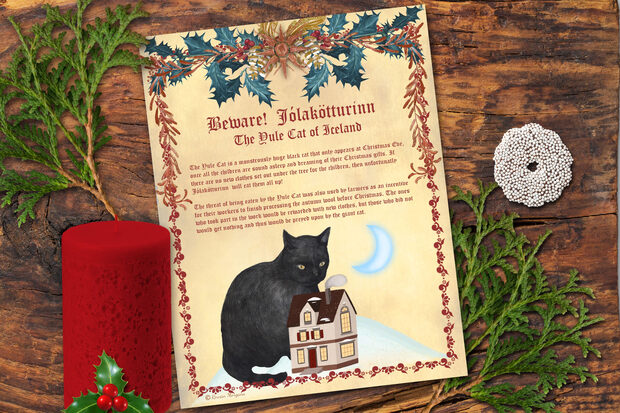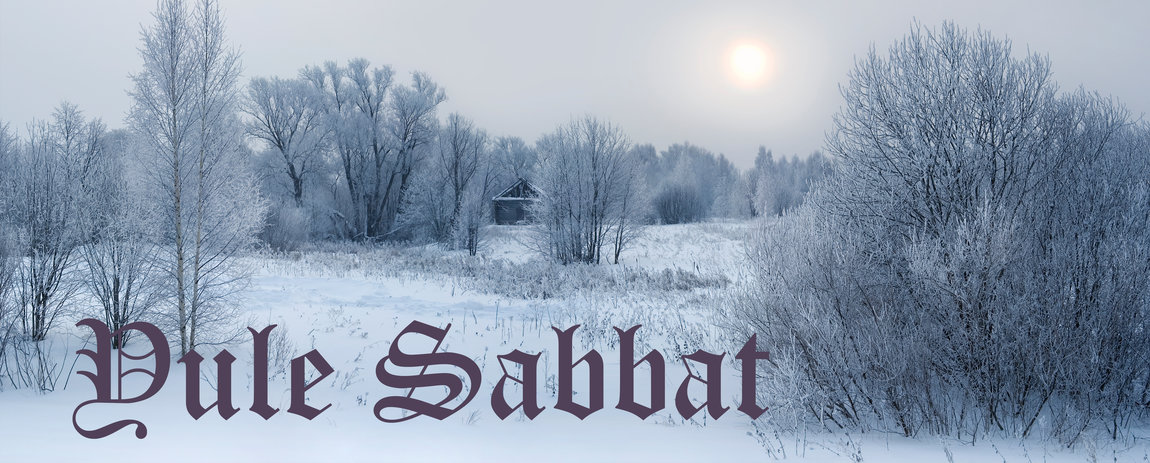
Winter Solstice Dec. 20, 21st or 22nd
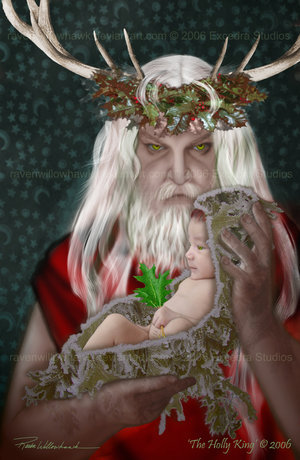 The solstice occurs when the sun reaches its most southerly declination of -23.5 degrees.
The solstice occurs when the sun reaches its most southerly declination of -23.5 degrees.
In other words, it is when the North Pole has tilted 23.5 degrees away from the sun
When the wheel has turned to Yule,
light the log the Horned One rules.
Yule is celebrated at the Midwinter Solstice, the shortest day of the year. The word Yule comes from the Germanic “Jul” and means “Wheel.” At Yule, we celebrate winter and the rebirth of the Sun. At Samhain, the Goddess followed the God into the Underworld and the Earth began its long winter slumber. As the Wheel turns to Yule, the Goddess is with child and gives birth to the tiny Oak King, God of the waxing Sun. The Old God or Holly King is defeated and returns to the Underworld to rest until Summer Solstice when he will again be reborn as Lord of the waning Sun.
At Yule, we mourn the passing of the Old God who is the Lord of Winter. This ancient God has many names besides the Holly King, including Cernunnos, Odin, Harlequin, and of course Santa Claus. This God is portrayed as an old man, majestic and often jolly. Sometimes He is shown as a King in ermine-trimmed robes, other times He is shown as a Jester and called the King of Fools. The Old God is the Lord of Death and of the Spirit World and magic. He is the God of the forest, of animals, and of the hunt. Often He is shown with antlers or horns.
Yule is also a celebration of the birth of the Sun King and nature’s renewal. We practice sympathetic magick by lighting fires or candles to encourage the sun to grow stronger. This is a time of new beginnings both physically and spiritually, the wheel of the year has made a complete circle. The darkest night of winter is a good time for self-examination and discovering the “seeds” of spiritual growth or hindrance which are lying dormant within us. The Winter Solstice is the turning point in the natural cycle of the year, this darkest night in all the year is followed by a day that will dawn just a little earlier!
Altar and ritual space decorations include evergreen wreaths and boughs, pine cones, red and green candles, pine-scented incense and essential oils of myrrh and frankincense. Peppermint leaf and mistletoe are the herbs of Yule. The colour scheme of white and gold and Solar images are also very appropriate.

Yule Correspondences
Animals: Bear, Boar, Squirrel, Stag, Sow, Tiger
Birds: Eagle, Kingfisher, Lapwing, Owl, Robin, Snow Goose, Wren
Colors: Gold, Green, Red, Silver, White
Goddesses: Aphrodite, Fortuna, Gaia, Hel, Holle, Ishtar, Isis
Gods: Apollo, Attis, Balder, Dionysus, the Green Man, Lugh, Odin, Ra
Herbs: Blessed Thistle, Chamomile, Ivy, Mistletoe, Rosemary, Sage
Incense: Cedar, Frankincense, Juniper, Myrrh, Pine
Metals: Gold, Silver
Stones: Bloodstone, Clear Quartz, Diamond, Emerald, Garnet, Ruby
Trees: Apple, Birch, Cedar, Chestnut, Fir, Holly, Juniper, Oak, Pine, Yew
Zodiac: Capricorn, Sagittarius

Yule Traditions and Symbols
Bells – ancient pagans would ring bells to drive away demons that surfaced during the cold dark winter.
Candles – burned to help melt winter’s chill and to encourage the sun to shine.
Peppermint leaf and tea – the coolness of peppermint symbolizes winter and the heat of peppermint symbolizes the Sun.
Elves – Alfaheimr, the land of Elves, was inhabited by spirits who created the Sun. Including Elves in the Yule ritual encourages them to rejuvenate the Sun and make it shine again.
Evergreens – because evergreen trees remained green throughout the winter, they were thought to have power over death and could defeat winter demons roaming the earth and urge the coming of the Sun.
Holly – the vibrant green leaves and bright red berries that appear during the winter symbolize rebirth.
Lights – homes and holiday trees were decorated with candles to frighten away unwanted spirits and to encourage the Sun to shine.
Mistletoe – To the Druids, the white berries symbolized the semen of the Gods and were used to bring fertility and abundance. Hung over the doorway, it protects from thunder, lightning, and malicious evil.
The Norse Goddess Frigg loved Her son Baldur so much that She couldn’t bear the thought of any harm coming to Him. She made a pact with the Four Elements that nothing in Their realms would do Him harm. Loki fashioned an arrow from mistletoe, and the arrow killed Baldur. Frigg’s tears restored her Son to life, and She was so happy that She declared mistletoe a plant of luck, love, and promise. To kiss under the mistletoe is to receive Frigg’s blessing.
Ornaments – Germanic people originally decorated their trees with fruit, candy, cookies and flowers to symbolize the abundance to come when the Sun begins to warm the Earth once again.
Plum Pudding – was prepared as a form of divination rather than a dish to be eaten. As the pudding was prepared, each family member stirred the pot and made a wish. Then a ring, a coin, a button, and a thimble were added to the pot. The ring stood for marriage, the coin for wealth, the button and the thimble were symbols of the eternal bachelor or spinster. If one of these items turned up in your serving of pudding, it foretold your personal status during the coming year.
Reindeer – May represent the stags that drew the chariot of the Norse Goddess Freya. Stags also represent the Celtic horned God Cernunnos.
Santa Claus – May have originated from legends of Odin the Lord of Winds, who was capable of flying through the stormiest nights or with the Norse Sun-God Kris Kringle.
Sleigh – Freya spent the twelve days after Solstice being transported in a sleigh, giving gifts to the nice and misery offerings to the naughty.
Snowflake – the snowflake was formed from the tears that Demeter cried after Persephone’s descent into the Underworld. Snowflakes have 6 sides, and six is the numerological number associated with love.
Tree – Saint Boniface, during the 8th century, was trying to convert a group of Druids to Christianity. He could not convince them that the oak tree was neither sacred nor invincible, so he cut one down, and when it fell, it crushed everything in its path but a single evergreen sapling. Boniface declared it a miracle and proclaimed that the fir tree belonged to the Christ-child. After that, they were brought into homes as holiday decorations.
Twelve Days of Christmas – Began with the ancient Egyptian Sun celebration, and is thought that the twelve-day celebration may have been designed to honor the zodiacal wheel.
Wassail – is the original name of an apple orchard fertility ritual and means hail or salute. Apple trees were saluted and then sprinkled with a mixture of eggs, apples, wine, ale or cider. Consecrating the trees this way ensured a good harvest for the coming year.
Wreath – The circular shape of a wreath symbolizes life everlasting, the never-ending cycle of birth, death, and rebirth.
Yule Log – to the Celts, the Yule Log was symbolic of the Oak King and was adorned with evergreens symbolic of the Holly King.

Yule Divination

Yuletide Pinecone Charm
I love this Yuletide pine cone charm, it doubles as a decoration and centerpiece while the magick is quietly doing its work! Go ahead and add other items to the basket to personalize the spell.
You will need the following supplies:
- glitter
- a basket (size, colour, and decoration are your choice)
- a square piece of felt or fabric measured to fit into the bottom of the basket (This keeps the glitter in place.)
- a dozen pinecones any other decorative or symbolic items you'd like to add (holly, ivy, oak leaves, birch twigs,or evergreen are great winter choices)
1. If desired, decorate the basket.
2. Place the felt in the bottom of the basket
3. Arrange the pinecones (and anything else you want to include) in the basket
4. Hold your hands over the pinecones and imagine the four elements of earth, air, fire, and water swirling around you. Picture this energy being funnelled through your hands into the basket.
5. Sprinkle the glitter onto the pinecones as you repeat this charm 3 times:
Pinecones are a natural symbol of fertility,
I enchant these to bring us good luck and prosperity,
By the winter winds that blow, and the sparkling snow that falls,
I call for joy and abundance to come bless us, one and all.
from Cottage Witchery by Ellen Dugan

Who is Santa Claus?
 He has been called by many names, Saint Nicholas, Father Christmas, Kris Kringle, and the Jolly Old Elf of Yule. He is a blend of Paganism, Christianity and modern myth-making in the form of stories, poems, songs and advertisements. He is Santa Claus, the white-haired, red-suited, gift-giving, the spirit of winter.
He has been called by many names, Saint Nicholas, Father Christmas, Kris Kringle, and the Jolly Old Elf of Yule. He is a blend of Paganism, Christianity and modern myth-making in the form of stories, poems, songs and advertisements. He is Santa Claus, the white-haired, red-suited, gift-giving, the spirit of winter.
The legend of Santa was strongly influenced by the Norse God Odin, who was the Germanic God of Mid-Winter (Yule). During the long nights of winter, it was believed that activity from the spirit world, increased. The “Wild Hunt” led by Odin riding an eight-legged grey horse, would stream across the winter sky with hunters, horses and hounds in mad pursuit. Odin’s horse Slepnir was capable of leaping great distances in a single bound and may be the origin of the Santa Claus reindeer legend. Odin’s Norse names are Jolnir (yule figure) and Langbaror (long beard). It’s very possible that the Old God Odin was influential in the way that the modern Santa was conceptualized. Odin, like our present-day Santa Claus, is depicted with a long white beard and is frequently wearing a hooded cloak. The flying horses of the “Wild Hunt” could have morphed into the present-day reindeer that pull Santa’s sleigh. To appease Odin and the hunters, children would place their shoes filled with carrots or hay for Slepnir near the chimney. Odin rewarded the children for their kindness to his horse by leaving gifts in their shoes. This may have been the origin of gift-giving and receiving at Yuletide.
The Christianized legend of Santa Claus started with Saint Nicholas in the 4th century. He was a Bishop of Myra in southwestern Turkey who gave generous gifts to the poor. He also performed miracles involving sailors and children. After he died he was made the patron saint of children and sailors and was given a feast day on December 6th. At around the same time, Pope Julius 1 decided to create a date for the birth of Jesus and decided to pick December 25th as it was close to the pagan midwinter solstice celebration. He hoped that because the dates were so close together that it would Christianize the pagan Yule celebration. Eventually, the Saint Nicholas feast day of December 6 became associated with December 25th and his association with Christmas was established. As much of Europe changed from Catholic to Protestant, Saint Nicholas lost popularity and was eventually replaced by the Dutch Sinterklaas.
Sinterklaas is often called The Good Saint. He is depicted as elderly, with white hair and a long full beard wearing a long red cape. Sinterklaas has a book in which contains notes on all children that indicate whether they've been good or bad. He rides a white/grey horse, has magickal helpers and brings gifts of chocolates and nuts to “good” children beginning on December 6. During the following three weeks, Sinterklaas rides his horse over the rooftops at night delivering gifts through the chimney to the good children. The hearth was held sacred and the chimney was the portal through which supernatural gifts from elves and faeries arrived. Naughty children were told that they risked being caught and punished by the magickal helpers of Sinterklaas. When the Dutch immigrated to the new world they brought Sinterklaas and the tradition of leaving out shoes to be filled with gifts with them. Eventually, Sinterklass’s name was Americanized into the modern Santa Claus.
In the 16th century, during the reign of Henry VIII, Father Christmas gained popularity as the English spirit of good cheer bringing peace, joy, good food, wine and gifts. Father Christmas was seen as a plump man wearing green or red robes lined with fur.
The modern Santa Claus was arguably invented by Washington Irving who wrote a satirical article about the Dutch tradition of Sinter Claes on December 6, 1809. In the article, he refers to an impish pipe-smoking Saint Nicholas who brings gifts down the chimney. The article was accepted as fact and the ideas and traditions were eventually adopted into the Christmas lore.
The beloved poem “Twas the Night before Christmas” by Clement Moore (1844) added to the lore of how Santa Claus looks and what he does. There is some controversy over the true authorship of the poem, which is said to have been published anonymously in 1823. The poem borrows heavily from Washington Irving and follows some of the Nordic and German myths. Interestingly there is not one religious reference or symbol found anywhere in the poem.
The popular image of Santa Claus was created by the drawings of Thomas Nast during the latter half of the 19th century. Nast added to Santa’s lore by depicting him reading letters from children, monitoring their behavior, and writing their names in the Naughty and Nice books. Nast also placed Santa in the North Pole with a toy workshop.
Saint or Pagan God, Santa Claus embodies the spirit of Christmas and Yuletide. He brings hope and joy during the longest nights of winter with gifts that are both physical and spiritual. He fills our stockings and brings us presents that are given to us with love and in the spirit of peace. He fills our hearts with joy and goodwill towards all. As Santa rides across the sky in his chariot pulled by reindeer, he brings hope and joy to the world and heralds the birth of the Divine Sun Child of the Pagans and the Divine Son of the Christians.
© Rowan Morgana 2013
Sources
- Wikipedia
- The Museum of Unnatural History
- About.com –The Origins of Santa Claus
- About.com – what’s so Christian about Santa Claus?
- The Father of Santa Claus
- The Complete Book of Correspondences - Sandra Kynes

Meet the Yule Cat of Iceland called Jólakötturinn. He's a big scary monster that comes down from the mountains and eats you if you don't wear new clothes at Christmas.

Yuletide Recipes
Glow Wine
from: The Wicca Cookbook
8 Cups (2 litres) Cabernet Sauvignon
1/2 Cup Sugar
8 Sticks Cinnamon
4 Slices Orange and Lemon
1 Tablespoon Lemon Juice
2 Tablespoons Orange Juice
12 Whole Cloves
Mix all the ingredients in a saucepan or a crockpot. Cover and simmer for 1 hour. Do not simmer without the lid unless you wish to evaporate most of the alcohol!
Hot Ginger Tea
from: The Wicca Cookbook
1 Large Knob Fresh Ginger
1 Stick Cinnamon
Several Lemon Slices
Several Whole Cloves stuck into the Lemon Slices
4 Cups Water
3/4 Cup Firmly Packed Brown Sugar or Honey
In a saucepan, combine the ginger, cinnamon, lemon slices with cloves, and water. Bring to a boil Decrease heat and simmer for 15 to 20 minutes. Sweeten with brown sugar or honey, to taste. Strain and serve hot.
Yule Moon Cookies
1 cup butter
1 1/4 cup sugar
2 tsp. grated lemon peel
1/4 tsp. salt
1 1/3 cup flour
1 1/2 cup grated almonds (blanched)
1 tsp. vanilla
Icing:
2 cups sifted confectioner's sugar
1 tsp. vanilla
2 1/2 Tbsp. water
Cream together butter and sugar until fluffy and light. Add grated lemon peel, salt, flour, grated almonds, and 1 tsp. vanilla; mix thoroughly. Place dough in bowl. Cover and chill thoroughly. When the dough is well chilled; or the next day, roll out dough to 1/8" thickness and cut with moon/crescent cookie cutter. Place 1/2" apart on un-greased baking sheet. Bake in preheated 375° oven for 8-10 minutes.
Icing: While cookies bake, combine confectioner's sugar, vanilla and water. Spread over the tops of cookies while still warm, but not too hot, as icing will melt. Thin with additional drops of water if glaze is too thick. Allow cookies to cool.
Yield: 10 dozen cookies
Bourbon Balls
Makes 30 one - inch candies.
1 6 oz package of semisweet chocolate pieces
3 tablespoons light corn syrup
1/4 cup bourbon
1/2 cup sugar
1 1/4 cups crushed vanilla wafer cookies (about 36)
1 cup finely chopped pecans
In a double boiler, melt the chocolate pieces, stirring constantly. Remove from heat and blend in corn syrup and bourbon. Stir in sugar, vanilla wafers and pecans until well blended. Allow to cool slightly. Pat about 1 teaspoon of the mixture into a ball with your hands. Roll each ball in sugar and place on a cookie sheet. Cover and chill several hours. To store, put in a wide mouth jar with a tight fitting lid.
DJ Conway
Orange-Cranberry Chicken with Sweet Potatoes
1 orange
1 4 lb. roasting chicken
1/2 tsp. pepper
1 lb. sweet potatoes
1 Tbsp. olive oil
1 cup chicken broth
1 cup whole berry Cranberry Sauce
2 Tbsp. white wine vinegar
Preheat oven to 375°. Grate rind from orange (don't include the bitter white part). Rinse chicken & pat dry. Sprinkle with salt, pepper, and 1/2 the grated orange rind. Place, breast side up, on a rack in large roasting pan. Roast for 30 minutes. Meanwhile, pare & cut the sweet potatoes into 1 inch slices, then toss with olive oil. Place in single layer in the bottom of roasting pan. Continue roasting 1 hour & 45 minutes, turning potatoes occasionally & basting chicken & potatoes frequently, until chicken juices run clear when the thickest part of the thigh is pierced with a fork and leg moves freely. During the last 1/2 hour of roasting, combine chicken broth, cranberry sauce and vinegar in a small saucepan. Bring to boiling over medium heat; boil 20 minutes or until reduced to 1 1/2 cups. Peel white pith from orange, seed flesh & chop. Stir remaining rind & chopped orange into saucepan; simmer 5 minutes. Let chicken rest for 20 minutes before carving. Cut chicken in half lengthwise down the middle. Spoon Cranberry Sauce mixture over chicken and serve with Sweet Potatoes.
Soft Gingerbread
1 cup sugar
1 cup molasses
1/2 cup butter or other shortening
3 cups flour
1 cup milk, sour
2 tsp. ginger
2 tsp. cinnamon
1 tsp. cloves
1/4 tsp. nutmeg
2 eggs, well beaten
1 tsp. baking soda, dissolved in 1/4 cup boiling water
Cream the shortening and sugar, add the eggs and molasses and mix well. Sift the flour and spices, and add alternately with the milk to the first mixture. Stir in the dissolved baking soda. Pour into well-greased cake pan and bake at 350° F for 30 minutes.

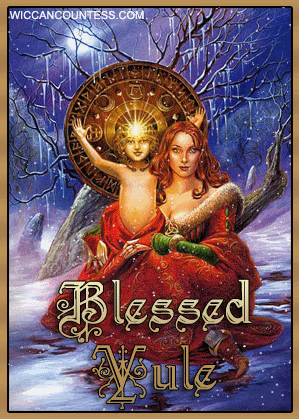
Yule Invocation of the Child of Light
Rowan Morgana
Tonight is the longest night of the year. A starry mantle of deepest dark cloaks the Earth. Many animals slumber in burrows and caves safe within the Mother.
From the beginning of time, humans have gathered together to witness the rebirth of the Divine Child of Promise, who will bring light and hope into the world.
We are in darkness. Inhale the comforts of the night deeply, and in that moment of stillness, before breath is released, we enter a time of magickal in-between. Allow the moment of magick to stretch into the infinite universe and begin to flow along the energy stream. We need nothing at this moment. We are complete.
Exhale completely. Yes, now we feel our need. The winter is long, and we are cold. The warmth of the Sun is but a memory in our bones. The earth is barren, and she sleeps under a mantle of snow and ice. We have eaten our grain, we have slaughtered our animals, and our fires are smaller. We still have many stories to share during the long nights. Stories of bravery and love of laughter and sorrow, of cowards and fools. All counted and recounted with meanings and magick cataloged.
Listen……The Elders have begun to chant. It is time to manifest the Child of Light. At this moment in time, winter must be mastered. If the Elders cannot call the Child, then all will be lost. Spring will not come, and the people will sleep forever. The chant becomes louder and faster, stronger and deeper, and the magick begins to swirl, faster, then faster, then faster still until it explodes into the night.
In each corner of the night sky, the Four Ancient Ones stir.
In the West Antares, the Fallen Angel brings forth the Cauldron of Rebirth.
In the North, Fomalhaut drives his staff of life into the Earth Mother.
In the South Regulus, the King conjures a tiny spark which he flings across the sky.
In the East, Aldebaran catches the spark and breathes it into flame.
The Ancient Ones open their arms to the Goddess, and She receives the tiny flame within Her Body. She knows that her people are weary of winter, and She smiles. Within her is the Child of Light promised to us at Mabon Sabbat. We have kept our faith with Her and She with us.
Close your eyes, Brothers and Sisters, for this is the last moment of darkness. Breathe it in.
Open your eyes, Brothers and Sisters, for the Child of Light is born.
Rejoice!

Lord of Mid Winter Invocation Spell
Cernunnos, Secalos, Santaclaus
Lord of Midwinter, give us pause
To think of you upon this night
And contemplate our heart's delight
For you are the giver of gifts held dear
Who rules the decline of the dying year
When we look inside and try to see
Our heart's secret and hidden mystery
Dreams and visions you inspire
Revealing in the midnight hour
What is hidden from the eyes of day
And the conscious mind has shut away
Inspiration's spark and our soul's small voice
Which guides us and inspires our choice
If we can but still our mind and hear
Of all gifts we hold this most dear
For in the still of the longest night
When the Moon provides the only light
You too Old Lord will look inside
To see what Your own Soul may hide
And there within Your own small spark
Will be rekindled and banish the dark
As the reborn Sun again ascends
And days grow long til Winter ends.
Don Lewis


Holly King
words by Lady Isadora
Sing we of a mystery, now as long ago
Blood red holly berries, blood upon on the snow
The Oak king shall rise, the waxing year to bring
Therefore bid we farewell to the Holly king
Now in deep midwinter all seems in a trance
Comes the golden Oak King in his age-old dance
Comes he to slay, yet honor he does he bring
To his fallen brother the darksome Holly King
In the bright midsummer the year's wheel turned around
Then shall be the Oak King's blood upon the ground
Ever it comes, once more the years waning
Then shall be victorious the Darksome Holly King
Sing we of the Mystery now as long ago
Blood red holly berries, blood upon on the snow
The Oak king shall rise waxing year to bring
Therefore bid we farewell to the Holly king
Sources:
Yule - Dorothy Morrison
BOS - Rowan Morgana
Incense, Oils & Brews - Scott Cunningham
Witch School - Rev. Don Lewis
Yule Printables

8841149


